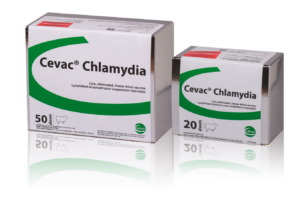25th March 2025
The EAE vaccine, Cevac Chlamydia, is now back in stock after supply challenges last year and vets are being encouraged to promote EAE (enzootic abortion of ewes) vaccination to farmers for ewe lambs and shearlings.
Farmers should be vaccinating their flocks to help protect the cohort of ewes that missed last year’s vaccination from the infection Chlamydiosis (also known as enzootic abortion of ewes or EAE), which is caused by the bacterium Chlamydophila abortus.
- Flock replacements should also be vaccinated this summer ahead of tupping.
- Shearlings (one year plus) and older can be vaccinated with Cevac Chlamydia within four months before tupping and no later than four weeks before the rams go in.
- Ewe lambs can be vaccinated from five months of age.
- The vaccine should not be used in pregnant ewes.
“It is really good news to hear that there will be good availability of EAE vaccine this year,” comments Fiona Lovatt BVSc PhD FHEA DSHP DipECSRHM FRCVS from Flock Health Ltd, past president of the Sheep Veterinary Society and RCVS and European-recognised specialist in sheep health and production. “The lambing season started off with some disappointing news for some farmers who were not able to vaccinate last year as they faced EAE abortions. We are emphasising to these farmers and others that it is essential that the youngest two years of the ewes are vaccinated before next tupping to ensure that the cohort that missed last year’s vaccination are fully covered.”
EAE is estimated to cost the UK sheep industry up to £20million annually1 and it is spread from sheep to sheep, predominantly at lambing, when affected ewes shed large numbers of the bacterium in their foetal fluids and placenta. Infection in a flock can result in the birth of dead and/or weak lambs from about three weeks before lambing is due to start. If sheep are infected after about 100 days of pregnancy they will not abort at this lambing, the bacterium becomes latent but then reactivates causing an abortion at the subsequent lambing. The highly infectious nature of chlamydia, as well as this latent infection, means that levels of abortion can be relatively low one year, before resulting in a storm and significant losses in the next year. Some ewes may not abort but can still shed the bacterium, meaning neonatal ewe lambs could be infected. In a previously uninfected flock the infection is generally bought in.
Katherine Timms BVetMed (Hons) MRCVS, ruminant veterinary advisor at Ceva, adds: “EAE is one of the biggest economic and welfare issues affecting sheep flocks each year and vaccination for EAE should be incorporated into flock health plans, particularly if there have been abortion cases during the preceding lambing. Veterinary practices can utilise practice management systems to proactively contact farming clients to discuss the benefits of vaccination well in advance of tupping.

“Farmers who are experiencing abortions among their flock should test for EAE if they have experienced an abortion rate of over two per cent in their flock or if two or more have aborted over two to three days irrespective of the size of flock. The best sample for testing is the whole aborted, fresh foetus and placenta. This can be sent to a lab for post-mortem and analysis. The Ceva supported EAE diagnostics runs for a full 12 months and includes serology, PCR or MZN options.”
For further information on Cevac Chlamydia including diagnostic support please contact your local Ceva territory manager or email rubu-uk@ceva.com.
Reference
- Milne C.E., et al. Epidemiological modelling of chlamydial abortion in sheep flocks, Veterinary Microbiology (2009), doi:10.1016/j.vetmic.2008.09.032
Legal Category for Cevac Chlamydia: UK POM-V
Prescription decisions are for the person prescribing the prescription alone. Further information is available from the product SPC, data sheet or pack insert. Use medicines responsibly (www.noah.co.uk/responsible)






